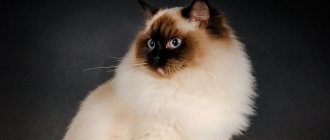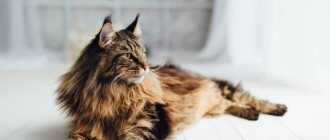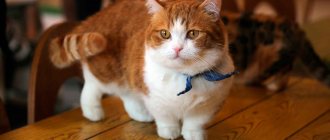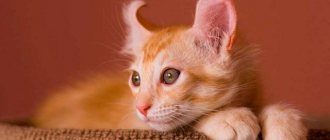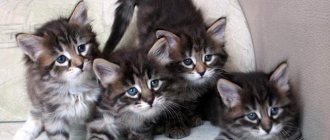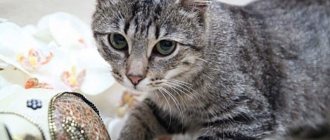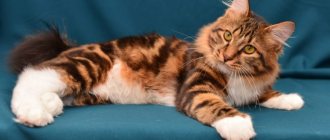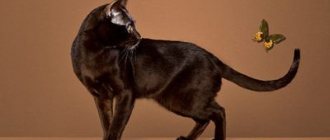Hypoallergenic cats are of interest to those who are prevented from having a four-legged friend by the hypersensitivity of the immune system. Allergies to cats are more common than to other animals. The topic turned out to be very relevant, so Petstory studied the issue, including contacting our veterinarians. In this article, we have prepared a list of hypoallergenic cat breeds for people with allergies and answered popular questions from users.
Causes of allergies
It is a mistake to believe that the reaction is caused by cat hair. In fact, the allergen is most often the Fel D1 protein found in the saliva and skin of cats. Particles of this protein are carried everywhere and, for the most part, settle on the fur - this is where this misconception comes from. There are known breeds of hypoallergenic cats that emit less dangerous protein.
However, for many allergy sufferers, their disease does not prevent them from living in the same house as a cat or even having contact with it. If you adhere to the rules of keeping a pet and correctly use the method of habituation to the “native” allergen (when the patient is regularly administered small doses of the allergen, gradually increasing the amount of the required component), then you can not only get rid of allergy symptoms, but also achieve clinical recovery. After such a course, a person will be able to live normally with his pet, but the reaction to other animals will persist.
This is interesting
Educational facts:
- the older the animal, the more protein it synthesizes;
- pets with light hair are safer than those with dark hair;
- in castrated and sterilized individuals, the amount of the enzyme decreases.
You can ask the breeder for a sample of the animal's saliva or fur. Biological materials are sent to the clinic.
Specialists will conduct a study to determine their compatibility with the blood of an allergic person and provide the result. Based on this, it will become clear whether the pet is suitable or not.
1111
Symptoms of a cat allergy
Signs of a respiratory allergy are:
- nasal congestion and allergic runny nose;
- burning and itching in the nasopharynx;
- shortness of breath, cough, sneezing;
- swelling of the nasopharynx.
Along with the listed symptoms, weakness and even fever can sometimes be observed.
On the skin, an allergy to cats that occurs through direct contact with an animal manifests itself as follows:
- irritation and itching of the skin;
- rashes, redness.
Other symptoms of cat allergies:
- headache;
- weakness;
- swelling of the eyes, profuse lacrimation.
Signs of allergies are varied and appear with varying intensities. Much depends on the characteristics of the human body and the breed of the animal.
How to choose the safest pet
If one of your household members has signs of an allergy to wool, then when choosing a pet you should be guided by the following:
- You should not choose semi- or long-haired breeds, varieties with a thick and thick undercoat.
- Persian, Angora, British, Scottish cats, and Maine Coons should definitely be excluded from the list of possible candidates.
- The highest content of allergen protein is produced by cats of dark colors and hairless pets.
- Mature pets produce more allergen, so pets need to be sterilized.
- Males are also more dangerous for allergy sufferers than females or kittens.
Balinese and Oriental
Are there any hypoallergenic cat breeds?
There are no breeds that are guaranteed not to cause an allergic reaction (so-called anti-allergenic cat breeds). But there are those with whom this happens much less often. Such cat breeds are conventionally called anti-allergenic. The point is the reduced production of a dangerous protein that settles on the wool. Animals of this type include:
- naked (hairless) cats. Lack of fur is not the main thing. Allergens that accumulate on the skin can be easily removed, for example, by bathing your pet.
- cats without undercoat. The undercoat plays an important role - during the molting period, allergens spread with greater intensity, and cats that do not have a lower layer of hair practically do not shed. True, this feature makes them vulnerable to the cold.
- cats with reduced production of dangerous proteins. Many people do not know that the existence of completely hypoallergenic cat breeds is a myth. The misconception is common because not everyone understands the nature of an allergic reaction. For example, Sphynx cats are often classified as non-allergenic breeds due to their lack of fur, but these cats produce Fel D1 just like any other. Thus, there are simply no cat breeds to which there is no allergy.
Hypoallergenic cat breeds
Hypoallergenic are animal species that meet at least one of the listed criteria. We have compiled a list of cat breeds for allergy sufferers that produce minimal amounts of Fel D1. It is easier for people with allergies to live in the same area with such pets. Doctors recommend paying attention to the hair of animals: preferably pets without undercoat, hairless or curly breeds. The latter lose hair less often and do not spread it around the house.
Siberian cat
Size: medium, closer to large
Wool: medium length
Lifespan: 12–15 years
The secret of the “Siberians” is the reduced production of Fel D1. The breed was developed in Russia several centuries ago. They are thick-coated tabby cats of medium to large size, with a strong build and large, strong paws. “Siberians” are distinguished by a large head and eyes of a golden or greenish hue. Representatives of this breed are famous for their playfulness, intelligence, devotion and good nature.
Bengal
Size: medium
Wool: short
Lifespan: 12–16 years
This breed is hypoallergenic due to its short, silky coat, which hardly sheds. Bengals are the result of crossing a domestic cat with an Asian leopard. They are distinguished by a muscular build, a triangular head and, of course, a characteristic leopard print color. They are energetic, intelligent and friendly, easily getting along with people and animals. Bengal cats simply love to swim, but water procedures are recommended for them no more than once every three months.
Oriental
Size: medium
Wool: short, long
Lifespan: 15–20 years
These cats are notable for their low Fel D1 content and low shedding. Orientals are an experimental species descended from Siamese cats. There are both short-haired and long-haired representatives of the breed. They can be described as graceful animals with an exotic appearance (thanks to their large, widely spaced ears). The body is elongated, the head forms the shape of an equilateral triangle, the eyes are most often emerald in color, the limbs are long, the color is varied. Oriental cats are friendly and inquisitive.
Balinese
Size: medium
Wool: semi-long
Lifespan: 13–16 years
Hypoallergenicity of Balinese dogs is achieved due to the low protein concentration. Another important factor is the lack of undercoat. Balinese cats are proud, graceful animals with an aristocratic bearing. They have an athletic build and well-developed muscles. The color can be different, the most common are blue point, frost point, seal point. Balinese cats are extremely sociable and require a lot of attention. They do not tolerate loneliness and silence in the house. They are smart, inquisitive, and always want to be in the center of events. Balinese cats are among the ten smartest cat breeds in the world.
Siamese
Size: small
Wool: short
Lifespan: 15-20 years
The breed, due to its thin and short fur, is characterized by mild shedding. Siamese cats are animals with ideal proportions, flexible bodies and elegant thin legs. They are characterized by color-point color (light coat with dark areas on the paws, face, ears and tail) and its variations. “Siamese” are smart, loyal to one owner, and do not tolerate loneliness well. In addition, they are too jealous and will not share human attention with other pets, so it is difficult to call them conflict-free.
Neva Masquerade
Size: closer to large
Wool: long
Life expectancy: 15-18 years
This breed appeared by crossing “Siberians” and “Siams”, adopting the hypoallergenic properties of both. Neva masquerade cats are distinguished by thick soft fur, blue eyes, and a dark muzzle against the background of a light fur coat. Externally, these cats are strong, proportional, with a strong physique. Representatives of the breed have a calm and unobtrusive character, they are quite independent and do not require increased attention to themselves.
Ocicat
Size: medium
Wool: short
Life expectancy: 16-20 years
These felines do not have undercoat, which is why they are considered hypoallergenic. The Ocicat has a powerful and even heavy body, strong bones and an exotic spotted color. These are smart, affectionate and sociable pets; their peculiarity is that they do not become attached to a specific home and easily tolerate moving.
Hurry up, choose a box and find out what gift awaits you
Discount on pet insurance
Promo code copied to clipboard
Burmanskaya
Size: small
Wool: short
Lifespan: 15-20 years
Short-haired Burmese cats hardly shed and also have no undercoat. They are distinguished by a muscular, strong body, short shiny fur, and large yellow eyes. The coat can be of almost any color. It can be uniform or dark spots may appear on the face, paws and tail. Burmese are affectionate, playful, loyal to people, and get along well with other cats and dogs in the house.
Javanese
Size: smaller than average
Wool: medium length
Lifespan: 12-15 years
“Javanese” are close relatives of Orientals, bred by crossing Balinese and Siamese cats. They have no undercoat. Javanese cats have large ears, an elongated body, slender limbs, a long tail and a graceful build. The color can be anything. The character has willfulness, stubbornness and determination. They are active, playful and curious creatures.
Napoleon (minuet)
Size: small
Wool: length may vary
Lifespan: 12-15 years
Despite the fact that Napoleon's ancestors were fluffy Persian cats, they shed very little. The body is oblong, with a wide back and powerful neck. The hind legs are traditionally longer than the front ones. The luxurious tail is set high and raised up when walking. The coat color is varied. Cats of the Minuet breed are smart, affectionate, sociable, and do not tolerate loneliness well.
Lykoi (Likoi)
Size: medium
Wool: short
Life expectancy: from 15 years
This is a recently bred breed with huge, expressive eyes and patchy hair that is distributed unevenly over the body. It grows in clumps, and during molting the hair can completely disappear. Because of this, allergens simply do not have time to accumulate in the wool. Lykoi are harmoniously built, thin-legged animals with an unusual appearance. Despite their stern appearance, they are kind, obedient and affectionate pets. From the first days they become attached to their owner, but they also feel comfortable alone.
Devon Rex
Size: medium
Wool: short
Life expectancy: 12-17 years
Their hypoallergenicity is due to their super short wavy fur. The appearance of Devons is exotic - large ears, piercing eyes, soft curly hair of various shades. This is an affectionate, intelligent and moderately active pet that loves its owners and always strives to be close to them.
Cornish Rex
Size: medium
Wool: short
Lifespan: 12-14 years
Rex, like the Devon and Cornish, has a unique coat - it is short, curly and practically does not shed. Therefore, it is recognized as a non-allergenic cat breed. The main characteristics of the Cornish Rex: light, graceful, tall, long-legged. This breed is considered one of the most playful, active and cheerful.
Peterbald
Size: medium
Wool: practically absent
Lifespan: 13-15 years
A breed of hairless, hypoallergenic cats bred in Russia. Peterbalds have a long and narrow head, a straight profile, almond-shaped eyes and large ears. The main character traits are sociability, friendliness, and affection.
Don Sphynx
Size: large
Wool: practically absent
Lifespan: 12-15 years
These hairless cats, like the Peterbalds, were bred in our country. Sometimes juveniles have a small amount of hair on the face and paws. By nature, Don Sphynxes are affectionate and friendly animals that can find an approach to any person. They are able to express emotions using facial expressions and voice.
Choosing a kitten, cost
The Burmese cat constantly collects positive reviews, which attracts the attention of buyers. However, you need to buy a pet only in a specialized nursery, or from a trusted breeder. Choosing the right animal is the key to its future health. Kittens are handed over at the age of 3-4 months. The appearance of the kitten plays an important role.
Signs of a healthy litter:
- clean wool without bald spots;
- no discharge from the eyes or nose;
- clean ears;
- playful and curious mood.
Starting price in Moscow – 20 thousand rubles. A show-class kitten costs 40-60 thousand rubles. Kittens without a pedigree can be sold for 10-15 thousand rubles. However, no matter how much a pet costs, its character and behavior are always impeccable.
List of breeds to avoid for allergy sufferers
This division is conditional. It all depends on the type of allergy.
Therefore, the most allergenic cat breeds are an individual concept. The following breeds can be noted:
- Persians and exotics. They produce protein in large quantities, and their long hair helps spread it.
- Maine Coon, Norwegian Forest, American Bobtail, Cymric. These owners of thick fur with an undercoat shed heavily, which is why allergens are carried everywhere along with the hairs.
Sphinxes. They secrete protein during regular water procedures, so Sphynx cats can be considered hypoallergenic. However, frequent bathing does not benefit these cats. Their skin begins to peel, and fallen scales become an additional allergen.
American and European Burmese type
The Burmese cat breed is divided into 2 varieties: European and American type. The American type looks more exotic - it is distinguished by a rounded, flattened muzzle, thick skin and dense hair. The American Burmese cat has expressive round eyes. They create a special expression on the face.
The European Burmese cat has an elongated muzzle - the head tends to take the shape of a rounded wedge. The European type of cat differs in the description of its fur; it does not have such gloss and shine. The skin is thinner. The American Burmese cat will always be heavier than the European one. In general, Europeans are more similar to the British.
Features of caring for an animal if there is an allergy sufferer in the house
If you follow the rules for caring for animals recommended for people with allergies, the likelihood of unwanted reactions is significantly reduced.
- Bathe cats 1-3 times a week.
- Clean your cat's bed as often as possible, and it's also important to wash and wash toys.
- Wipe hairless pets with wet wipes without alcohol. Hairy cats need to be brushed at least once a week.
- Keep your pet's litter box clean.
- Wash your hands after every contact with your cat.
If it is possible to entrust the care of your cat to a person who does not suffer from allergies, then it is worth doing so. It should also be said about the benefits of sterilization, which leads to reduced production of Fel D1.
Photo and video
Photos of adults and kittens:
Video:
Video: Burmese cat 101kote.Ru burmese 101cats
Video: Burmese cat all about the breed. Interesting Facts
Video: Burmese kitten - features of education
The Burmese shorthair cat is a wonderful pet. These are very sociable, kind and playful creatures that do not require careful care. Be sure to leave personal reviews if you have ever had contact with a Burmese, or you are the owner of one.

